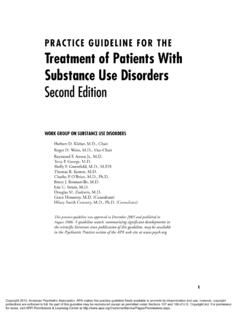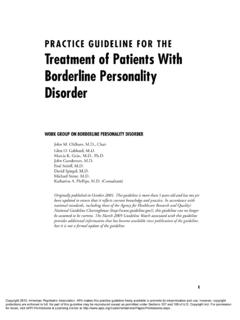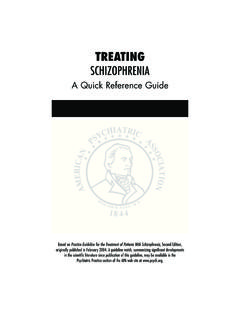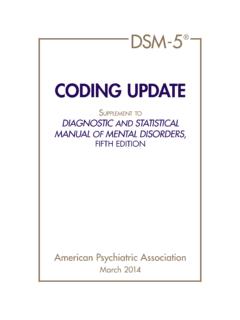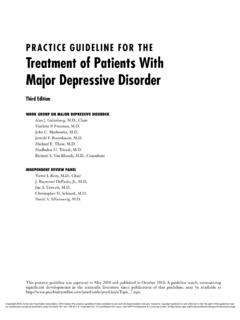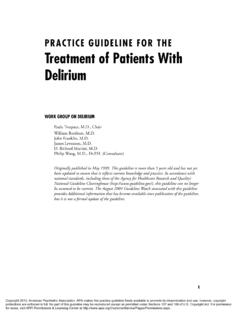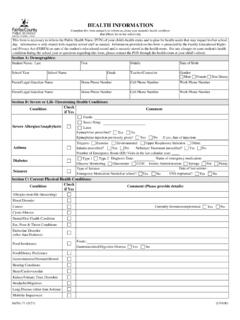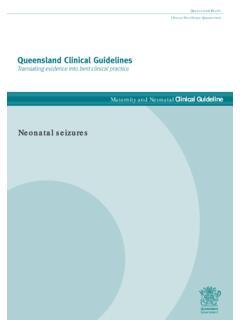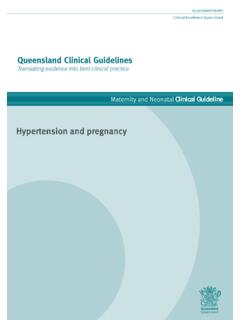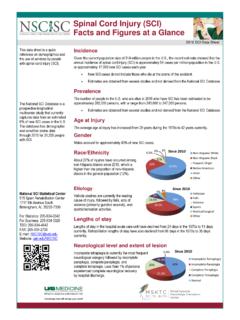Transcription of PRACTICE GUIDELINE FOR THE Treatment of Patients With ...
1 PRA CT ICE GU IDEL INE FO R TH E. Treatment of Patients With schizophrenia Second Edition WORK GROUP ON schizophrenia . Anthony F. Lehman, , , Chair Jeffrey A. Lieberman, , Vice-Chair Lisa B. Dixon, , Thomas H. McGlashan, Alexander L. Miller, Diana O. Perkins, , Julie Kreyenbuhl, , (Consultant). Originally published in February 2004. This GUIDELINE is more than 5 years old and has not yet been updated to ensure that it reflects current knowledge and PRACTICE . In accordance with national standards, including those of the Agency for Healthcare Research and Quality's National GUIDELINE Clearinghouse ( ), this GUIDELINE can no longer be assumed to be current. 1. Copyright 2010, American Psychiatric Association. APA makes this PRACTICE GUIDELINE freely available to promote its dissemination and use; however, copyright protections are enforced in full.
2 No part of this GUIDELINE may be reproduced except as permitted under Sections 107 and 108 of Copyright Act. For permission for reuse, visit APPI Permissions & Licensing Center at AMERICAN PSYCHIATRIC ASSOCIATION. STEERING COMMITTEE ON PRACTICE GUIDELINES. John S. McIntyre, , Chair Sara C. Charles, , Vice-Chair Daniel J. Anzia, Ian A. Cook, Molly T. Finnerty, Bradley R. Johnson, James E. Nininger, Paul Summergrad, Sherwyn M. Woods, , Joel Yager, AREA AND COMPONENT LIAISONS. Robert Pyles, (Area I). C. Deborah Cross, (Area II). Roger Peele, (Area III). Daniel J. Anzia, (Area IV). John P. D. Shemo, (Area V). Lawrence Lurie, (Area VI). R. Dale Walker, (Area VII). Mary Ann Barnovitz, Sheila Hafter Gray, Sunil Saxena, Tina Tonnu, STAFF. Robert Kunkle, , Senior Program Manager Amy B. Albert, , Assistant Project Manager Laura J. Fochtmann, , Medical Editor Claudia Hart, Director, Department of Quality Improvement and Psychiatric Services Darrel A.
3 Regier, , , Director, Division of Research 2 APA PRACTICE Guidelines Copyright 2010, American Psychiatric Association. APA makes this PRACTICE GUIDELINE freely available to promote its dissemination and use; however, copyright protections are enforced in full. No part of this GUIDELINE may be reproduced except as permitted under Sections 107 and 108 of Copyright Act. For permission for reuse, visit APPI Permissions & Licensing Center at CONTENTS. Statement of Intent .. 5. Guide to Using This PRACTICE GUIDELINE .. 6. Development Process .. 7. Part A: Treatment Recommendations for Patients With schizophrenia .. 9. I. Executive Summary .. 9. A. Coding System .. 9. B. Formulation and Implementation of a Treatment Plan .. 9. C. Establishing a Therapeutic Alliance .. 10. D. Acute Phase Treatment .. 10. E. Stabilization Phase .. 12.
4 F. Stable Phase .. 12. G. Other Specific Treatment Issues .. 14. H. Treatment Settings and Housing Options .. 16. II. Formulation and Implementation of a Treatment Plan .. 17. A. Psychiatric Management .. 17. B. Acute Phase .. 22. C. Stabilization Phase .. 33. D. Stable Phase .. 34. E. Special Issues in Caring for Patients With Treatment -Resistant Illness .. 39. F. Clinical Features Influencing the Treatment Plan .. 40. III. Treatment Settings and Housing Options .. 54. A. Choice of Treatment Setting or Housing .. 54. B. Common Treatment Settings .. 54. Part B: Background Information and Review of Available Evidence .. 61. IV. Disease Definition, Natural History and Course, and Epidemiology .. 61. A. Clinical Features .. 61. B. Natural History and Course.. 63. C. Epidemiology .. 64. V. Review and Synthesis of Available Evidence.
5 66. A. Pharmacological Treatments .. 66. B. Other Somatic Therapies .. 101. C. Specific Psychosocial Interventions .. 104. Part C: Future Research Directions .. 114. Individuals and Organizations That Submitted Comments .. 115. References .. 116. Treatment of Patients With schizophrenia 3. Copyright 2010, American Psychiatric Association. APA makes this PRACTICE GUIDELINE freely available to promote its dissemination and use; however, copyright protections are enforced in full. No part of this GUIDELINE may be reproduced except as permitted under Sections 107 and 108 of Copyright Act. For permission for reuse, visit APPI Permissions & Licensing Center at Copyright 2010, American Psychiatric Association. APA makes this PRACTICE GUIDELINE freely available to promote its dissemination and use; however, copyright protections are enforced in full.
6 No part of this GUIDELINE may be reproduced except as permitted under Sections 107 and 108 of Copyright Act. For permission for reuse, visit APPI Permissions & Licensing Center at STATEMENT OF INTENT. The American Psychiatric Association (APA) PRACTICE Guidelines are not intended to be con- strued or to serve as a standard of medical care. Standards of medical care are determined on the basis of all clinical data available for an individual patient and are subject to change as sci- entific knowledge and technology advance and PRACTICE patterns evolve. These parameters of PRACTICE should be considered guidelines only. Adherence to them will not ensure a successful outcome for every individual, nor should they be interpreted as including all proper methods of care or excluding other acceptable methods of care aimed at the same results.
7 The ultimate judgment regarding a particular clinical procedure or Treatment plan must be made by the psy- chiatrist in light of the clinical data presented by the patient and the diagnostic and Treatment options available. This PRACTICE GUIDELINE has been developed by psychiatrists who are in active clinical prac- tice. In addition, some contributors are primarily involved in research or other academic endeavors. It is possible that through such activities some contributors, including work group members and reviewers, have received income related to treatments discussed in this guide- line. A number of mechanisms are in place to minimize the potential for producing biased recommendations due to conflicts of interest. Work group members are selected on the basis of their expertise and integrity. Any work group member or reviewer who has a potential con- flict of interest that may bias (or appear to bias) his or her work is asked to disclose this to the Steering Committee on PRACTICE Guidelines and the work group.
8 Iterative GUIDELINE drafts are reviewed by the Steering Committee, other experts, allied organizations, APA members, and the APA Assembly and Board of Trustees; substantial revisions address or integrate the com- ments of these multiple reviewers. The development of the APA PRACTICE guidelines is not financially supported by any commercial organization. More detail about mechanisms in place to minimize bias is provided in a document avail- able from the APA Department of Quality Improvement and Psychiatric Services, APA. GUIDELINE Development Process.. This PRACTICE GUIDELINE was approved in December 2003 and published in February 2004. Treatment of Patients With schizophrenia 5. Copyright 2010, American Psychiatric Association. APA makes this PRACTICE GUIDELINE freely available to promote its dissemination and use; however, copyright protections are enforced in full.
9 No part of this GUIDELINE may be reproduced except as permitted under Sections 107 and 108 of Copyright Act. For permission for reuse, visit APPI Permissions & Licensing Center at GUIDE TO USING THIS PRACTICE GUIDELINE . The PRACTICE GUIDELINE for the Treatment of Patients With schizophrenia , Second Edition, consists of three parts (Parts A, B, and C) and many sections, not all of which will be equally useful for all readers. The following guide is designed to help readers find the sections that will be most useful to them. Part A, Treatment Recommendations for Patients With schizophrenia , is published as a supplement to the American Journal of Psychiatry and contains general and specific Treatment recommendations. Section I summarizes the key recommendations of the GUIDELINE and codes each recommendation according to the degree of clinical confidence with which the recom- mendation is made.
10 Section II is a guide to the formulation and implementation of a Treatment plan for the individual patient. Section , Clinical Features Influencing the Treatment Plan, . discusses a range of clinical considerations that could alter the general recommendations dis- cussed in Section II. Section III describes Treatment settings and housing options and provides guidance on choice of setting. Part B, Background Information and Review of Available Evidence, and Part C, Future Research Directions, are not included in the American Journal of Psychiatry supplement but are provided with Part A in the complete GUIDELINE , which is available in print format from American Psychiatric Publishing, Inc., and online through the American Psychiatric Associa- tion ( ). Part B provides an overview of schizophrenia , including general information on its natural history, course, and epidemiology.
